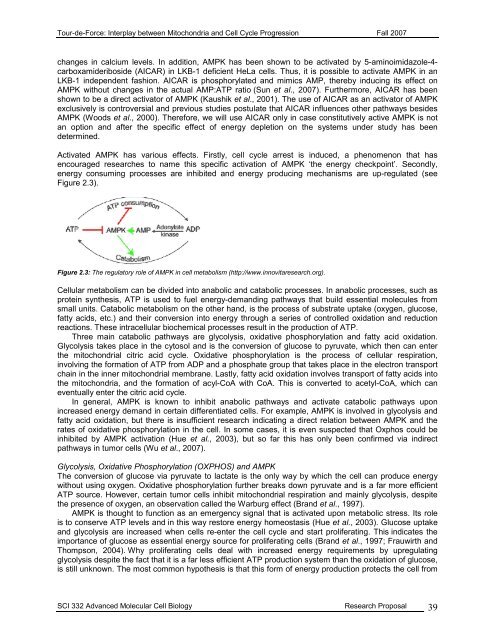Tour-de-Force
Tour-de-Force
Tour-de-Force
Create successful ePaper yourself
Turn your PDF publications into a flip-book with our unique Google optimized e-Paper software.
<strong>Tour</strong>-<strong>de</strong>-<strong>Force</strong>: Interplay between Mitochondria and Cell Cycle Progression Fall 2007changes in calcium levels. In addition, AMPK has been shown to be activated by 5-aminoimidazole-4-carboxami<strong>de</strong>ribosi<strong>de</strong> (AICAR) in LKB-1 <strong>de</strong>ficient HeLa cells. Thus, it is possible to activate AMPK in anLKB-1 in<strong>de</strong>pen<strong>de</strong>nt fashion. AICAR is phosphorylated and mimics AMP, thereby inducing its effect onAMPK without changes in the actual AMP:ATP ratio (Sun et al., 2007). Furthermore, AICAR has beenshown to be a direct activator of AMPK (Kaushik et al., 2001). The use of AICAR as an activator of AMPKexclusively is controversial and previous studies postulate that AICAR influences other pathways besi<strong>de</strong>sAMPK (Woods et al., 2000). Therefore, we will use AICAR only in case constitutively active AMPK is notan option and after the specific effect of energy <strong>de</strong>pletion on the systems un<strong>de</strong>r study has been<strong>de</strong>termined.Activated AMPK has various effects. Firstly, cell cycle arrest is induced, a phenomenon that hasencouraged researches to name this specific activation of AMPK ‘the energy checkpoint’. Secondly,energy consuming processes are inhibited and energy producing mechanisms are up-regulated (seeFigure 2.3).Figure 2.3: The regulatory role of AMPK in cell metabolism (http://www.innovitaresearch.org).Cellular metabolism can be divi<strong>de</strong>d into anabolic and catabolic processes. In anabolic processes, such asprotein synthesis, ATP is used to fuel energy-<strong>de</strong>manding pathways that build essential molecules fromsmall units. Catabolic metabolism on the other hand, is the process of substrate uptake (oxygen, glucose,fatty acids, etc.) and their conversion into energy through a series of controlled oxidation and reductionreactions. These intracellular biochemical processes result in the production of ATP.Three main catabolic pathways are glycolysis, oxidative phosphorylation and fatty acid oxidation.Glycolysis takes place in the cytosol and is the conversion of glucose to pyruvate, which then can enterthe mitochondrial citric acid cycle. Oxidative phosphorylation is the process of cellular respiration,involving the formation of ATP from ADP and a phosphate group that takes place in the electron transportchain in the inner mitochondrial membrane. Lastly, fatty acid oxidation involves transport of fatty acids intothe mitochondria, and the formation of acyl-CoA with CoA. This is converted to acetyl-CoA, which caneventually enter the citric acid cycle.In general, AMPK is known to inhibit anabolic pathways and activate catabolic pathways uponincreased energy <strong>de</strong>mand in certain differentiated cells. For example, AMPK is involved in glycolysis andfatty acid oxidation, but there is insufficient research indicating a direct relation between AMPK and therates of oxidative phosphorylation in the cell. In some cases, it is even suspected that Oxphos could beinhibited by AMPK activation (Hue et al., 2003), but so far this has only been confirmed via indirectpathways in tumor cells (Wu et al., 2007).Glycolysis, Oxidative Phosphorylation (OXPHOS) and AMPKThe conversion of glucose via pyruvate to lactate is the only way by which the cell can produce energywithout using oxygen. Oxidative phosphorylation further breaks down pyruvate and is a far more efficientATP source. However, certain tumor cells inhibit mitochondrial respiration and mainly glycolysis, <strong>de</strong>spitethe presence of oxygen, an observation called the Warburg effect (Brand et al., 1997).AMPK is thought to function as an emergency signal that is activated upon metabolic stress. Its roleis to conserve ATP levels and in this way restore energy homeostasis (Hue et al., 2003). Glucose uptakeand glycolysis are increased when cells re-enter the cell cycle and start proliferating. This indicates theimportance of glucose as essential energy source for proliferating cells (Brand et al., 1997; Frauwirth andThompson, 2004). Why proliferating cells <strong>de</strong>al with increased energy requirements by upregulatingglycolysis <strong>de</strong>spite the fact that it is a far less efficient ATP production system than the oxidation of glucose,is still unknown. The most common hypothesis is that this form of energy production protects the cell fromSCI 332 Advanced Molecular Cell Biology Research Proposal 39
















